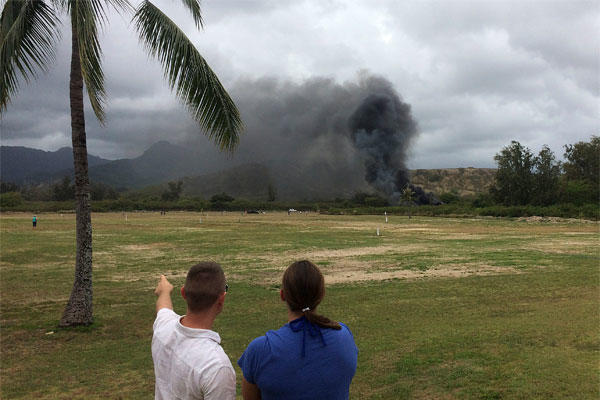A second Marine has died of injuries suffered in the training exercise crash of an MV-22 Osprey tilt-rotor aircraft on the island of Oahu in Hawaii, the Marine Corps said Wednesday.
The Marine's family was notified but his name was not immediately released. He died early Wednesday at a hospital in Oahu, the Marine Corps said. Two other Marines who were aboard the Osprey remain hospitalized in stable condition, said Capt. Brian Block, a spokesman for the 15th Marine Expeditionary Unit.
On Tuesday, the Marines said that Lance Cpl. Joshua E. Barron, 24, of Spokane, Wash., a crew chief aboard the Osprey, was killed when the aircraft went down Sunday in the Marines' Training Area Bellows. A total of 21 Marines and one Navy Corpsman were aboard the Osprey.
Barron was assigned to Marine Medium Tiltrotor Squadron 161 (Rein.), of the 15th Marine Expeditionary Unit (MEU). The MEU was conducting final training exercises before deploying to the Middle East aboard the Amphibious Ready Group led by the amphibious assault ship Essex.
The cause of the accident that occurred Sunday in daytime and in clear weather was under investigation by the 1st Marine Expeditionary Force based in Camp Pendleton, Calif.
The Osprey accident was the second "Class A" flight mishap, in which there was a fatality or $2 million in damages, for Marine Corps aviation in less than a week. On May 11, six Marines and two Nepalese soldiers were killed in Nepal in the crash of their UH-1Y Huey helicopter while on an earthquake relief mission.
In background material, the Marine Corps said that despite the two recent accidents, "historical data shows that Marine Corps aviation, both in terms of platforms and piloting, is safe -- there is no evidence to suggest otherwise."
The Marines' Class A mishap rate per 100,000 flight hours for all aircraft was 1.83 in Fiscal Year 2010; 4.18 in FY 2011; 2.54 in FY 2012; 3.66 in FY2013; 2.30 in FY2014; and 3.66 in FY2015. Two other Marine aircraft had worse Class A mishap rates than the Osprey.
Since 2010, the Class A mishap rates per 100,000 hours flight time for individual Marine aircraft were: KC-130: 0.00; F/A-18 Hornet: 1.89; AH-1 Cobra attack helicopter: 2.25; CH-53E helicopter: 2.34; EA-6B Prowler: 2.70; CH-46 helicopter: 2.98; MV-22 Osprey: 3.20; AV-8B Harrier 3.66; UH-1 Huey helicopter (N and Y versions); 3.72.
The Marines have staunchly defended the Osprey's tilt-rotor design and air worthiness against attempts to kill the program, most notably in the 1990s by then-Defense Secretary Dick Cheney.
In testing, the Osprey had a total of seven Class A accidents resulting in 36 deaths. Since becoming operational in 2007, the Osprey has had three crashes resulting in six fatalities -- not including Sunday's accident in Hawaii.
-- Richard Sisk can be reached at richard.sisk@military.com
Related Video
Osprey Evolution




























